RMIT Management: Age Diversity in the Contemporary Workplace
VerifiedAdded on 2022/09/01
|5
|1174
|18
Report
AI Summary
This report delves into the complexities of managing age diversity in the workplace, a critical aspect of contemporary management due to globalization and varied generational cohorts. It examines the challenges managers face, particularly with Generation Z employees, including their limited work experience and the need for effective onboarding. The report highlights the importance of understanding generational differences, employee expectations, and the application of scientific management principles to standardize work and promote fairness. It explores both the positive aspects of age diversity, such as knowledge complementarities and improved decision-making, and the potential for reduced cohesion due to differing values. The report also references relevant literature and case studies, providing a comprehensive overview of strategies for fostering an inclusive and productive work environment across different age groups.
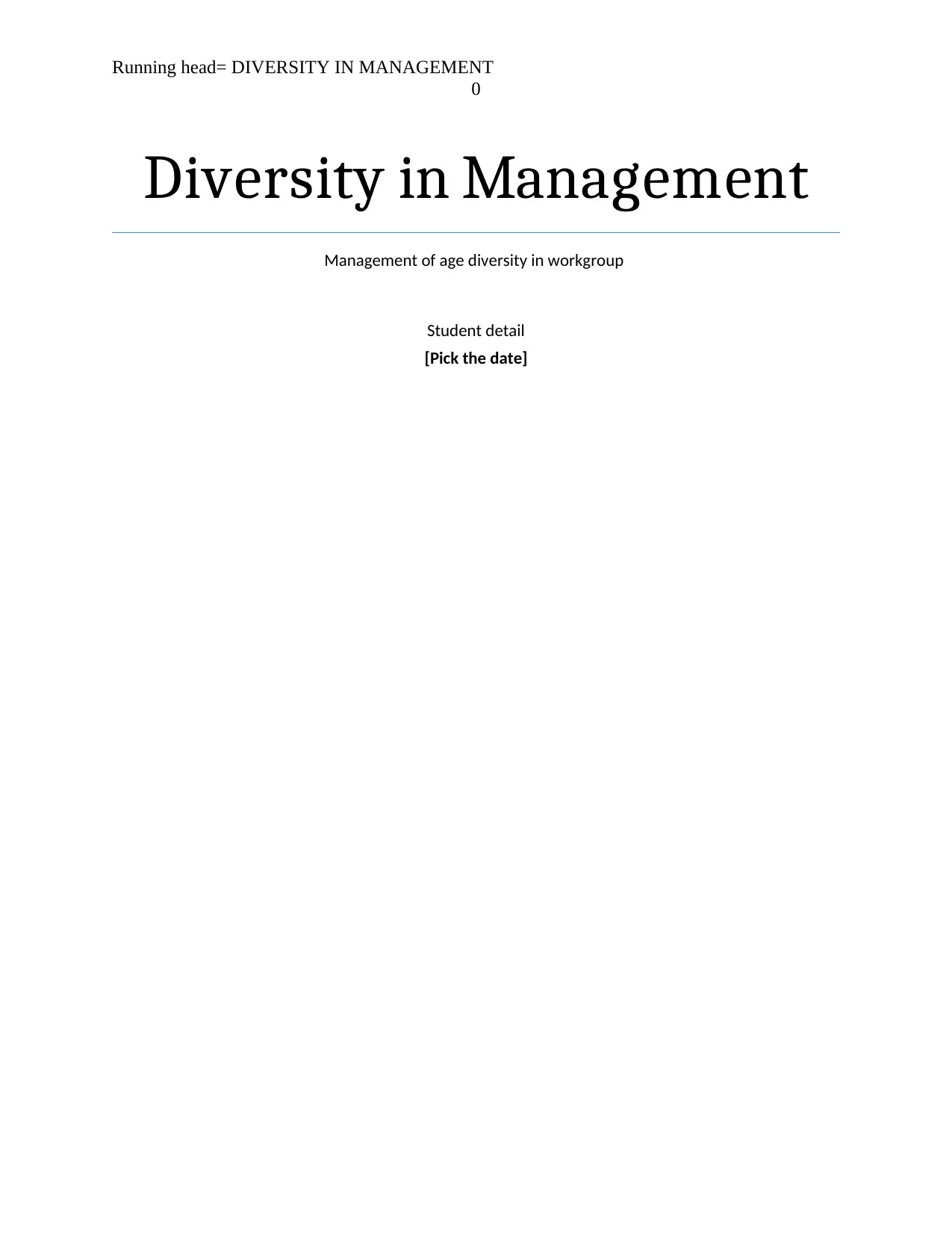
Running head= DIVERSITY IN MANAGEMENT
0
Diversity in Management
Management of age diversity in workgroup
Student detail
[Pick the date]
0
Diversity in Management
Management of age diversity in workgroup
Student detail
[Pick the date]
Paraphrase This Document
Need a fresh take? Get an instant paraphrase of this document with our AI Paraphraser
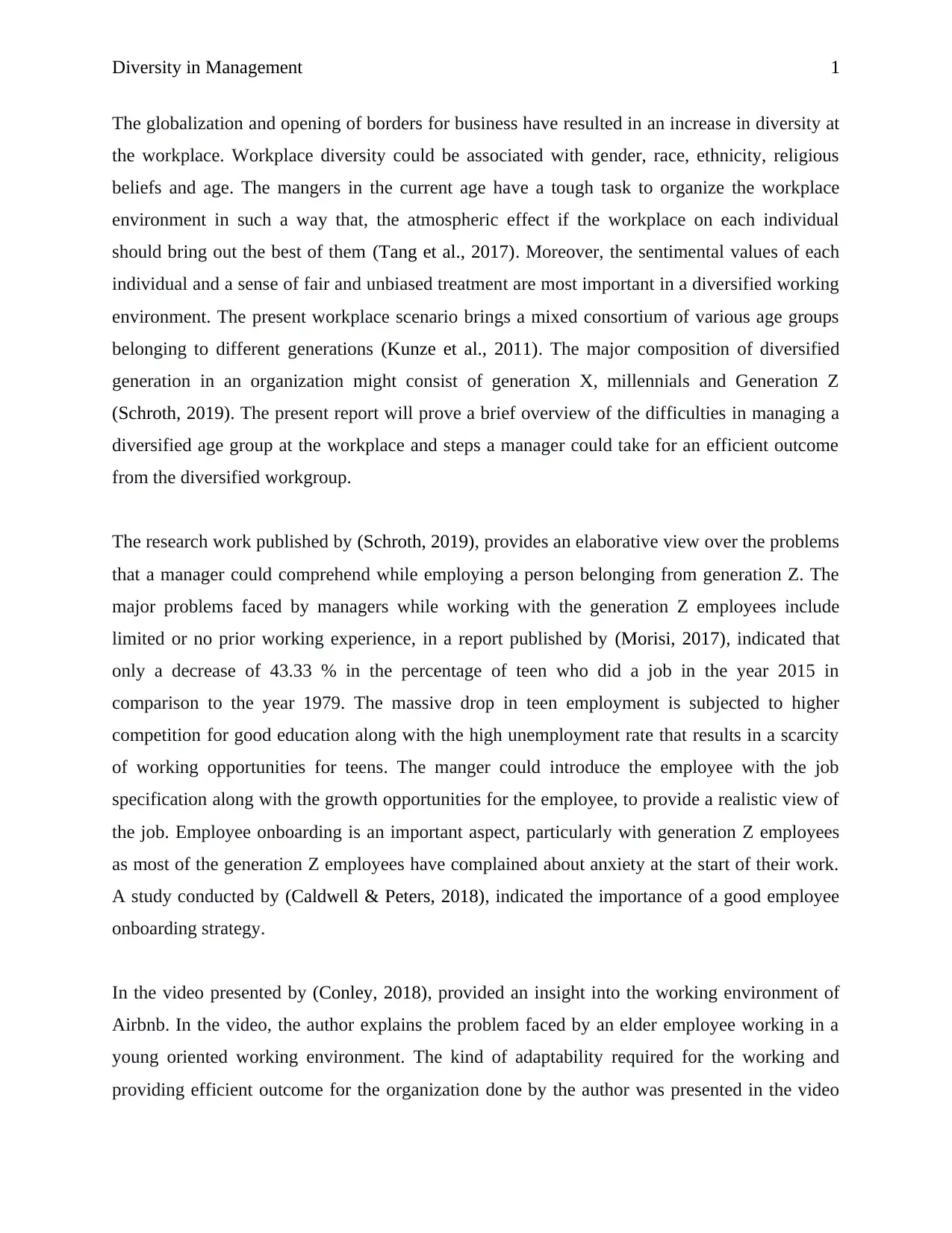
Diversity in Management 1
The globalization and opening of borders for business have resulted in an increase in diversity at
the workplace. Workplace diversity could be associated with gender, race, ethnicity, religious
beliefs and age. The mangers in the current age have a tough task to organize the workplace
environment in such a way that, the atmospheric effect if the workplace on each individual
should bring out the best of them (Tang et al., 2017). Moreover, the sentimental values of each
individual and a sense of fair and unbiased treatment are most important in a diversified working
environment. The present workplace scenario brings a mixed consortium of various age groups
belonging to different generations (Kunze et al., 2011). The major composition of diversified
generation in an organization might consist of generation X, millennials and Generation Z
(Schroth, 2019). The present report will prove a brief overview of the difficulties in managing a
diversified age group at the workplace and steps a manager could take for an efficient outcome
from the diversified workgroup.
The research work published by (Schroth, 2019), provides an elaborative view over the problems
that a manager could comprehend while employing a person belonging from generation Z. The
major problems faced by managers while working with the generation Z employees include
limited or no prior working experience, in a report published by (Morisi, 2017), indicated that
only a decrease of 43.33 % in the percentage of teen who did a job in the year 2015 in
comparison to the year 1979. The massive drop in teen employment is subjected to higher
competition for good education along with the high unemployment rate that results in a scarcity
of working opportunities for teens. The manger could introduce the employee with the job
specification along with the growth opportunities for the employee, to provide a realistic view of
the job. Employee onboarding is an important aspect, particularly with generation Z employees
as most of the generation Z employees have complained about anxiety at the start of their work.
A study conducted by (Caldwell & Peters, 2018), indicated the importance of a good employee
onboarding strategy.
In the video presented by (Conley, 2018), provided an insight into the working environment of
Airbnb. In the video, the author explains the problem faced by an elder employee working in a
young oriented working environment. The kind of adaptability required for the working and
providing efficient outcome for the organization done by the author was presented in the video
The globalization and opening of borders for business have resulted in an increase in diversity at
the workplace. Workplace diversity could be associated with gender, race, ethnicity, religious
beliefs and age. The mangers in the current age have a tough task to organize the workplace
environment in such a way that, the atmospheric effect if the workplace on each individual
should bring out the best of them (Tang et al., 2017). Moreover, the sentimental values of each
individual and a sense of fair and unbiased treatment are most important in a diversified working
environment. The present workplace scenario brings a mixed consortium of various age groups
belonging to different generations (Kunze et al., 2011). The major composition of diversified
generation in an organization might consist of generation X, millennials and Generation Z
(Schroth, 2019). The present report will prove a brief overview of the difficulties in managing a
diversified age group at the workplace and steps a manager could take for an efficient outcome
from the diversified workgroup.
The research work published by (Schroth, 2019), provides an elaborative view over the problems
that a manager could comprehend while employing a person belonging from generation Z. The
major problems faced by managers while working with the generation Z employees include
limited or no prior working experience, in a report published by (Morisi, 2017), indicated that
only a decrease of 43.33 % in the percentage of teen who did a job in the year 2015 in
comparison to the year 1979. The massive drop in teen employment is subjected to higher
competition for good education along with the high unemployment rate that results in a scarcity
of working opportunities for teens. The manger could introduce the employee with the job
specification along with the growth opportunities for the employee, to provide a realistic view of
the job. Employee onboarding is an important aspect, particularly with generation Z employees
as most of the generation Z employees have complained about anxiety at the start of their work.
A study conducted by (Caldwell & Peters, 2018), indicated the importance of a good employee
onboarding strategy.
In the video presented by (Conley, 2018), provided an insight into the working environment of
Airbnb. In the video, the author explains the problem faced by an elder employee working in a
young oriented working environment. The kind of adaptability required for the working and
providing efficient outcome for the organization done by the author was presented in the video
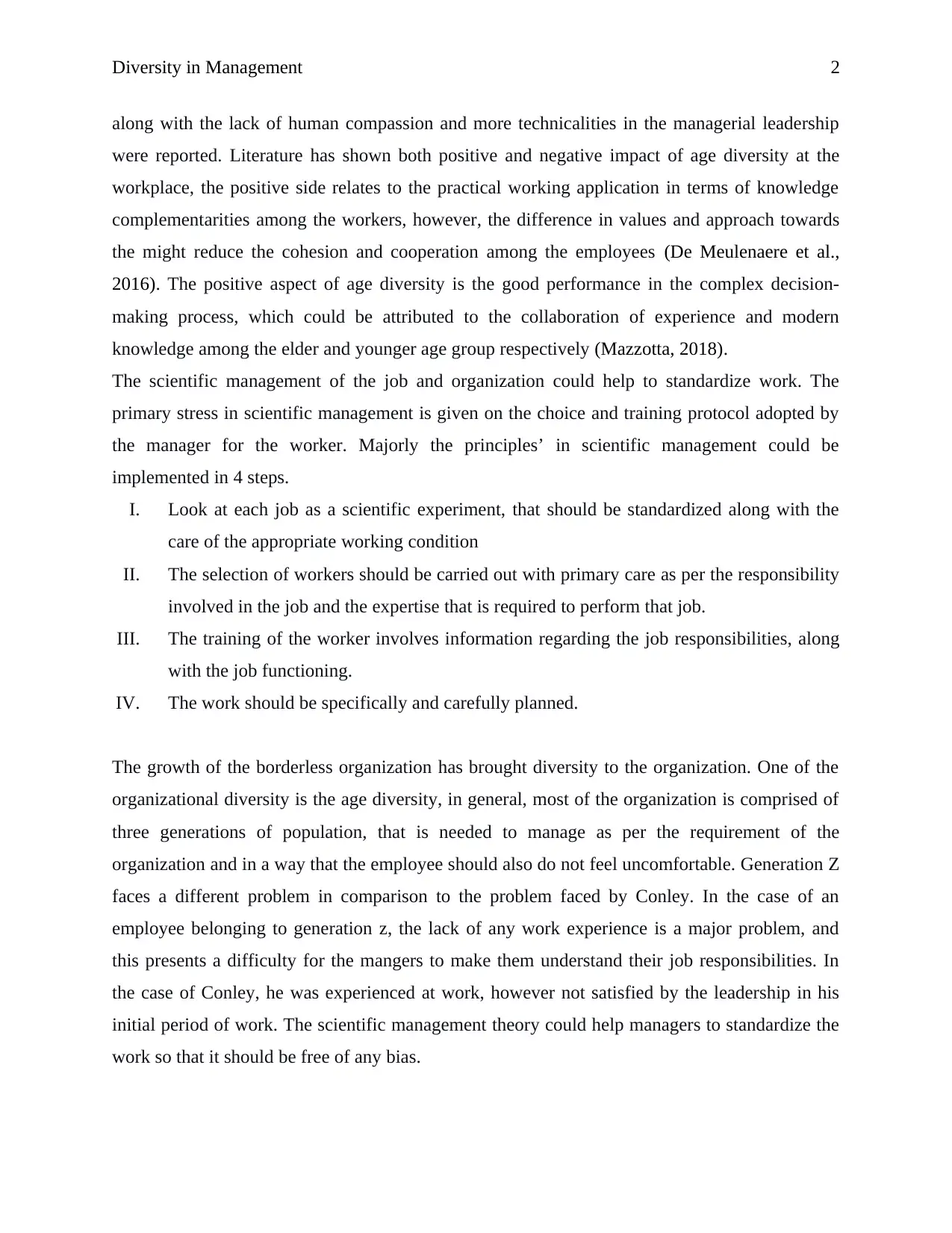
Diversity in Management 2
along with the lack of human compassion and more technicalities in the managerial leadership
were reported. Literature has shown both positive and negative impact of age diversity at the
workplace, the positive side relates to the practical working application in terms of knowledge
complementarities among the workers, however, the difference in values and approach towards
the might reduce the cohesion and cooperation among the employees (De Meulenaere et al.,
2016). The positive aspect of age diversity is the good performance in the complex decision-
making process, which could be attributed to the collaboration of experience and modern
knowledge among the elder and younger age group respectively (Mazzotta, 2018).
The scientific management of the job and organization could help to standardize work. The
primary stress in scientific management is given on the choice and training protocol adopted by
the manager for the worker. Majorly the principles’ in scientific management could be
implemented in 4 steps.
I. Look at each job as a scientific experiment, that should be standardized along with the
care of the appropriate working condition
II. The selection of workers should be carried out with primary care as per the responsibility
involved in the job and the expertise that is required to perform that job.
III. The training of the worker involves information regarding the job responsibilities, along
with the job functioning.
IV. The work should be specifically and carefully planned.
The growth of the borderless organization has brought diversity to the organization. One of the
organizational diversity is the age diversity, in general, most of the organization is comprised of
three generations of population, that is needed to manage as per the requirement of the
organization and in a way that the employee should also do not feel uncomfortable. Generation Z
faces a different problem in comparison to the problem faced by Conley. In the case of an
employee belonging to generation z, the lack of any work experience is a major problem, and
this presents a difficulty for the mangers to make them understand their job responsibilities. In
the case of Conley, he was experienced at work, however not satisfied by the leadership in his
initial period of work. The scientific management theory could help managers to standardize the
work so that it should be free of any bias.
along with the lack of human compassion and more technicalities in the managerial leadership
were reported. Literature has shown both positive and negative impact of age diversity at the
workplace, the positive side relates to the practical working application in terms of knowledge
complementarities among the workers, however, the difference in values and approach towards
the might reduce the cohesion and cooperation among the employees (De Meulenaere et al.,
2016). The positive aspect of age diversity is the good performance in the complex decision-
making process, which could be attributed to the collaboration of experience and modern
knowledge among the elder and younger age group respectively (Mazzotta, 2018).
The scientific management of the job and organization could help to standardize work. The
primary stress in scientific management is given on the choice and training protocol adopted by
the manager for the worker. Majorly the principles’ in scientific management could be
implemented in 4 steps.
I. Look at each job as a scientific experiment, that should be standardized along with the
care of the appropriate working condition
II. The selection of workers should be carried out with primary care as per the responsibility
involved in the job and the expertise that is required to perform that job.
III. The training of the worker involves information regarding the job responsibilities, along
with the job functioning.
IV. The work should be specifically and carefully planned.
The growth of the borderless organization has brought diversity to the organization. One of the
organizational diversity is the age diversity, in general, most of the organization is comprised of
three generations of population, that is needed to manage as per the requirement of the
organization and in a way that the employee should also do not feel uncomfortable. Generation Z
faces a different problem in comparison to the problem faced by Conley. In the case of an
employee belonging to generation z, the lack of any work experience is a major problem, and
this presents a difficulty for the mangers to make them understand their job responsibilities. In
the case of Conley, he was experienced at work, however not satisfied by the leadership in his
initial period of work. The scientific management theory could help managers to standardize the
work so that it should be free of any bias.
⊘ This is a preview!⊘
Do you want full access?
Subscribe today to unlock all pages.

Trusted by 1+ million students worldwide
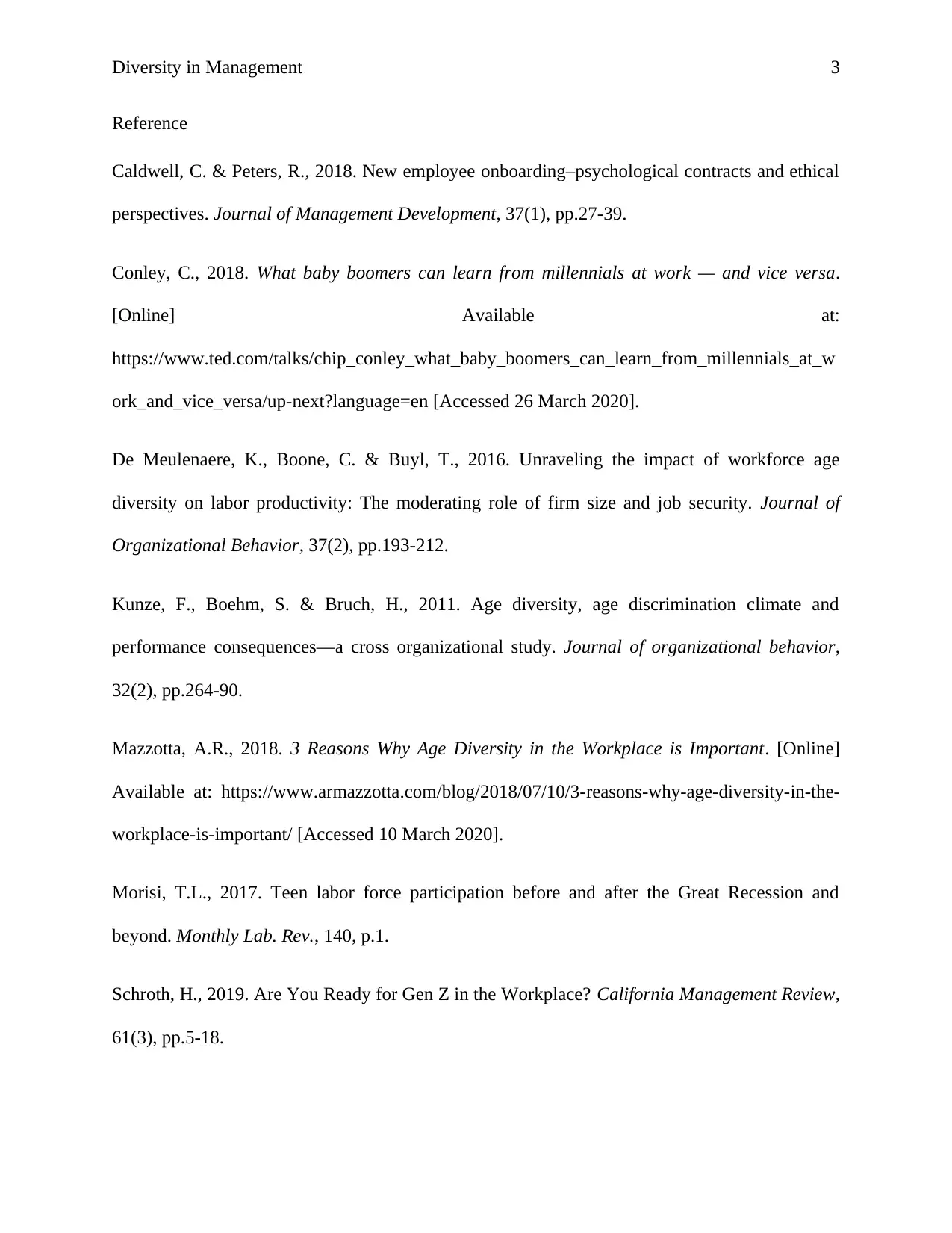
Diversity in Management 3
Reference
Caldwell, C. & Peters, R., 2018. New employee onboarding–psychological contracts and ethical
perspectives. Journal of Management Development, 37(1), pp.27-39.
Conley, C., 2018. What baby boomers can learn from millennials at work — and vice versa.
[Online] Available at:
https://www.ted.com/talks/chip_conley_what_baby_boomers_can_learn_from_millennials_at_w
ork_and_vice_versa/up-next?language=en [Accessed 26 March 2020].
De Meulenaere, K., Boone, C. & Buyl, T., 2016. Unraveling the impact of workforce age
diversity on labor productivity: The moderating role of firm size and job security. Journal of
Organizational Behavior, 37(2), pp.193-212.
Kunze, F., Boehm, S. & Bruch, H., 2011. Age diversity, age discrimination climate and
performance consequences—a cross organizational study. Journal of organizational behavior,
32(2), pp.264-90.
Mazzotta, A.R., 2018. 3 Reasons Why Age Diversity in the Workplace is Important. [Online]
Available at: https://www.armazzotta.com/blog/2018/07/10/3-reasons-why-age-diversity-in-the-
workplace-is-important/ [Accessed 10 March 2020].
Morisi, T.L., 2017. Teen labor force participation before and after the Great Recession and
beyond. Monthly Lab. Rev., 140, p.1.
Schroth, H., 2019. Are You Ready for Gen Z in the Workplace? California Management Review,
61(3), pp.5-18.
Reference
Caldwell, C. & Peters, R., 2018. New employee onboarding–psychological contracts and ethical
perspectives. Journal of Management Development, 37(1), pp.27-39.
Conley, C., 2018. What baby boomers can learn from millennials at work — and vice versa.
[Online] Available at:
https://www.ted.com/talks/chip_conley_what_baby_boomers_can_learn_from_millennials_at_w
ork_and_vice_versa/up-next?language=en [Accessed 26 March 2020].
De Meulenaere, K., Boone, C. & Buyl, T., 2016. Unraveling the impact of workforce age
diversity on labor productivity: The moderating role of firm size and job security. Journal of
Organizational Behavior, 37(2), pp.193-212.
Kunze, F., Boehm, S. & Bruch, H., 2011. Age diversity, age discrimination climate and
performance consequences—a cross organizational study. Journal of organizational behavior,
32(2), pp.264-90.
Mazzotta, A.R., 2018. 3 Reasons Why Age Diversity in the Workplace is Important. [Online]
Available at: https://www.armazzotta.com/blog/2018/07/10/3-reasons-why-age-diversity-in-the-
workplace-is-important/ [Accessed 10 March 2020].
Morisi, T.L., 2017. Teen labor force participation before and after the Great Recession and
beyond. Monthly Lab. Rev., 140, p.1.
Schroth, H., 2019. Are You Ready for Gen Z in the Workplace? California Management Review,
61(3), pp.5-18.
Paraphrase This Document
Need a fresh take? Get an instant paraphrase of this document with our AI Paraphraser
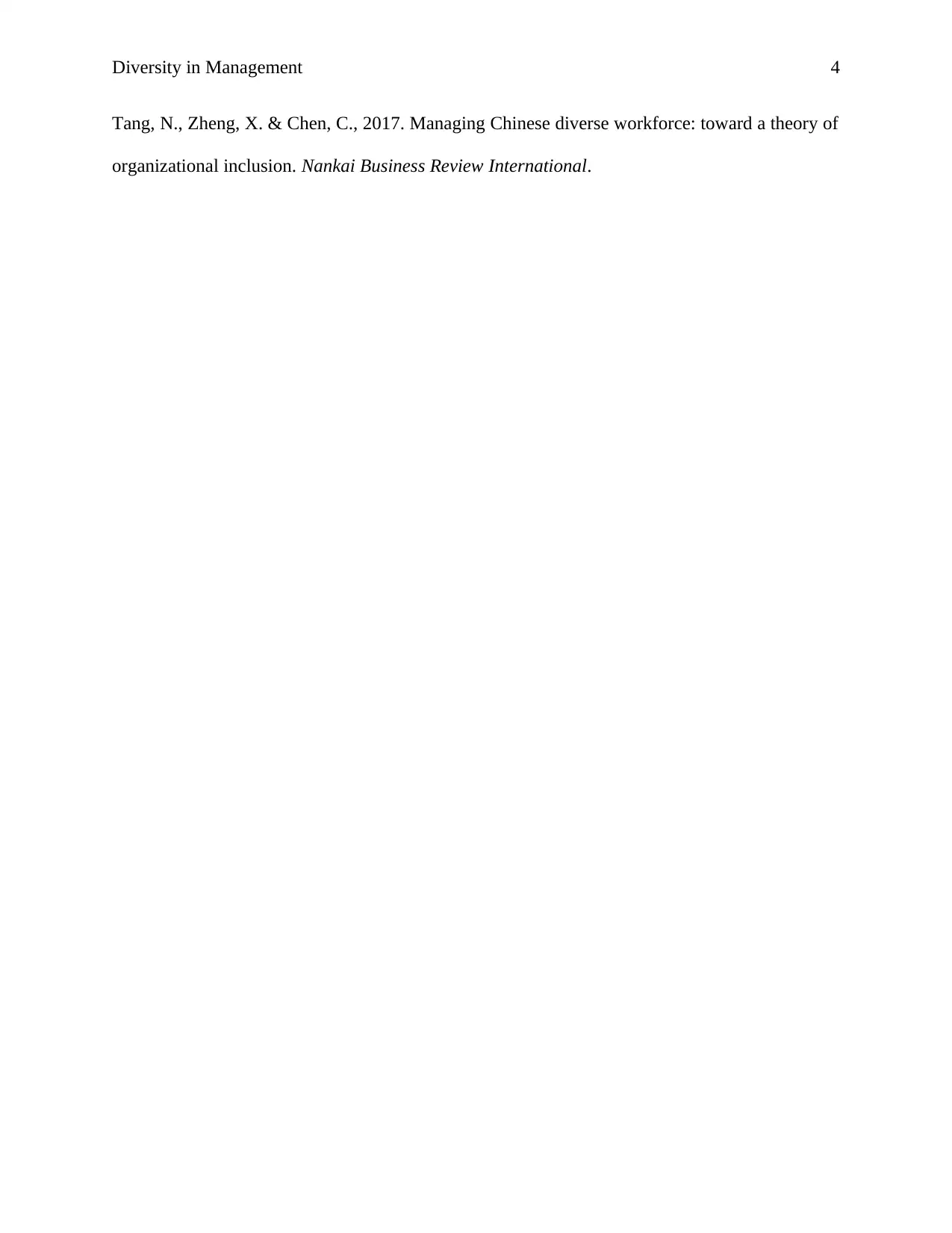
Diversity in Management 4
Tang, N., Zheng, X. & Chen, C., 2017. Managing Chinese diverse workforce: toward a theory of
organizational inclusion. Nankai Business Review International.
Tang, N., Zheng, X. & Chen, C., 2017. Managing Chinese diverse workforce: toward a theory of
organizational inclusion. Nankai Business Review International.
1 out of 5
Related Documents
Your All-in-One AI-Powered Toolkit for Academic Success.
+13062052269
info@desklib.com
Available 24*7 on WhatsApp / Email
![[object Object]](/_next/static/media/star-bottom.7253800d.svg)
Unlock your academic potential
Copyright © 2020–2025 A2Z Services. All Rights Reserved. Developed and managed by ZUCOL.





